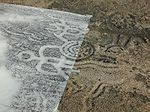
Gravestone rubbing
Encyclopedia

Crayon
A crayon is a stick of colored wax, charcoal, chalk, or other materials used for writing, coloring, drawing, and other methods of illustration. A crayon made of oiled chalk is called an oil pastel; when made of pigment with a dry binder, it is simply a pastel; both are popular media for color...
, graphite
Pencil
A pencil is a writing implement or art medium usually constructed of a narrow, solid pigment core inside a protective casing. The case prevents the core from breaking, and also from marking the user’s hand during use....
or inkstick
Inkstick
Inksticks are a type of solid ink used traditionally in several East Asian cultures for calligraphy and brush painting. Inksticks are made mainly of soot and animal glue, sometimes with incense or medicinal scents added...
s. Over time, the practice of stone rubbing can cause permanent damage to cultural monuments due to abrasion. For an artist, stone rubbings can become an entire body of creative work that is framed and displayed.
~~The Technique~~
The paper that has been used by Chinese scholars to transfer the calligraphy from stones is made from plant fiber. It can be used in two ways to retrieve the calligraphy. One way requires the paper to be dry and then adhered to the stone through a paste made with water and a starch that is made from rice or wheat. The paper is then tamped into the engravings on the stone. The other technique requires the paper to be wet and tamped into the engravings without a paste.
After doing either of these techniques, an ink, created through grinding an ink stick and adding water one drop at a time to achieve the ideal consistency, is used to retrieve the calligraphy. The ink is stippled on with a cloth filled with the ink. The ink covers the paper without sinking into the engravings. When the paper is peeled off, the calligraphy engravings come out white, while everything else is black from the ink.
More commonly, people use butcher paper to create stone rubbings. The butcher paper is usually taped on to the stone or grave, which contains the inscription desired, with either masking or paint tape. Then, usually, charcoal or crayon is rubbed over the stone or grave, leaving the engravings untouched by the crayon. When the butcher paper is removed, the inscriptions should be readable because they are not marked with the crayon.
It can be helpful to clean the stone beforehand, to ensure optimum results. A soft brush and water is usually what works best to cleanse the stones. One should not use stiff or hard brushes, as they can scratch the stone. Also, one should not use cleaning solutions or mild detergents on the stones, as they can damage the stone.
When stone rubbing, one should be careful with stones that are deteriorating, as they can collapse under pressure.
Gravestone rubbing
Gravestone rubbing also applies this technique to gravestones, often as a method of retrieving and conserving information about genealogyGenealogy
Genealogy is the study of families and the tracing of their lineages and history. Genealogists use oral traditions, historical records, genetic analysis, and other records to obtain information about a family and to demonstrate kinship and pedigrees of its members...
. For a genealogist, a gravestone rubbing may become a permanent record of death when a gravestone is rapidly deteriorating.
Rubbings are commonly made by visitors to the US Vietnam Veterans Memorial
Vietnam Veterans Memorial
The Vietnam Veterans Memorial is a national memorial in Washington, D.C. It honors U.S. service members of the U.S. armed forces who fought in the Vietnam War, service members who died in service in Vietnam/South East Asia, and those service members who were unaccounted for during the War.Its...
. Visitors use pencil and paper to copy the name of a family member or friend who died during the Vietnam war off of the wall. The rubbing forms a type of souvenir.
Gravestone rubbing can be used to teach about local history. The stone’s condition, art, and inscription can tell what was going on in an area at a specific time. Studying multiple gravestones in one specific area can give even more information about history.

